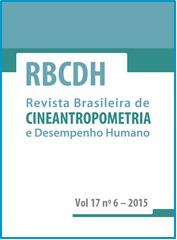Assimetrias cinéticas entre saltos para frente e saltos de queda
DOI:
https://doi.org/10.1590/1980-0037.2015v17n6p661Resumo
Assimetrias durante a aterrissagem de tarefas de salto são um fator de risco para lesão de ligamento cruzado anterior do joelho. O objetivo deste estudo foi identificar assimetrias cinéticas em atletas recreacionais saudáveis, enquanto realizavam diferentes tarefas de salto e aterrissagem. Doze atletas recreacionais que treinavam regularmente realizaram uma avaliação cinética, em que foram avaliadas as seguintes variáveis: (a) pico das forças de reação do solo (nas três componentes), (b) tempo para o pico de força vertical, e (c) assimetrias na fase inicial da aterrissagem. Os dados foram coletados durante a execução de saltos unilaterais e bilaterais, assim como de saltos para frente e saltos de queda. Saltos para frente demonstraram maiores assimetrias cinéticas comparados com os saltos de queda. Independente do tipo de salto, a perna preferida recebeu maiores cargas se comparada com a perna não preferida. A fase inicial da aterrissagem foi mais sensível na detecção de assimetrias cinéticas do que a fase mais tardia da aterrissagem, quando ocorrem os picos de força. Pode-se concluir que as avaliações para detectar assimetrias cinéticas em atletas, saltos para frente e a fase inicial da aterrissagem parecem ser mais sensíveis para a detecção dessas assimetrias.
Downloads
Publicado
Edição
Seção
Licença

Direitos Autorais para artigos publicados nesta revista são do autor, com direitos de primeira publicação para a revista. Em virtude da aparecerem nesta revista de acesso público, os artigos são de uso gratuito, com atribuições próprias, em aplicações educacionais e não-comerciais, desde que seja dada a atribuição. Esta obra foi licenciada com uma Licença Creative Commons Atribuição 4.0 Internacional - CC BY


